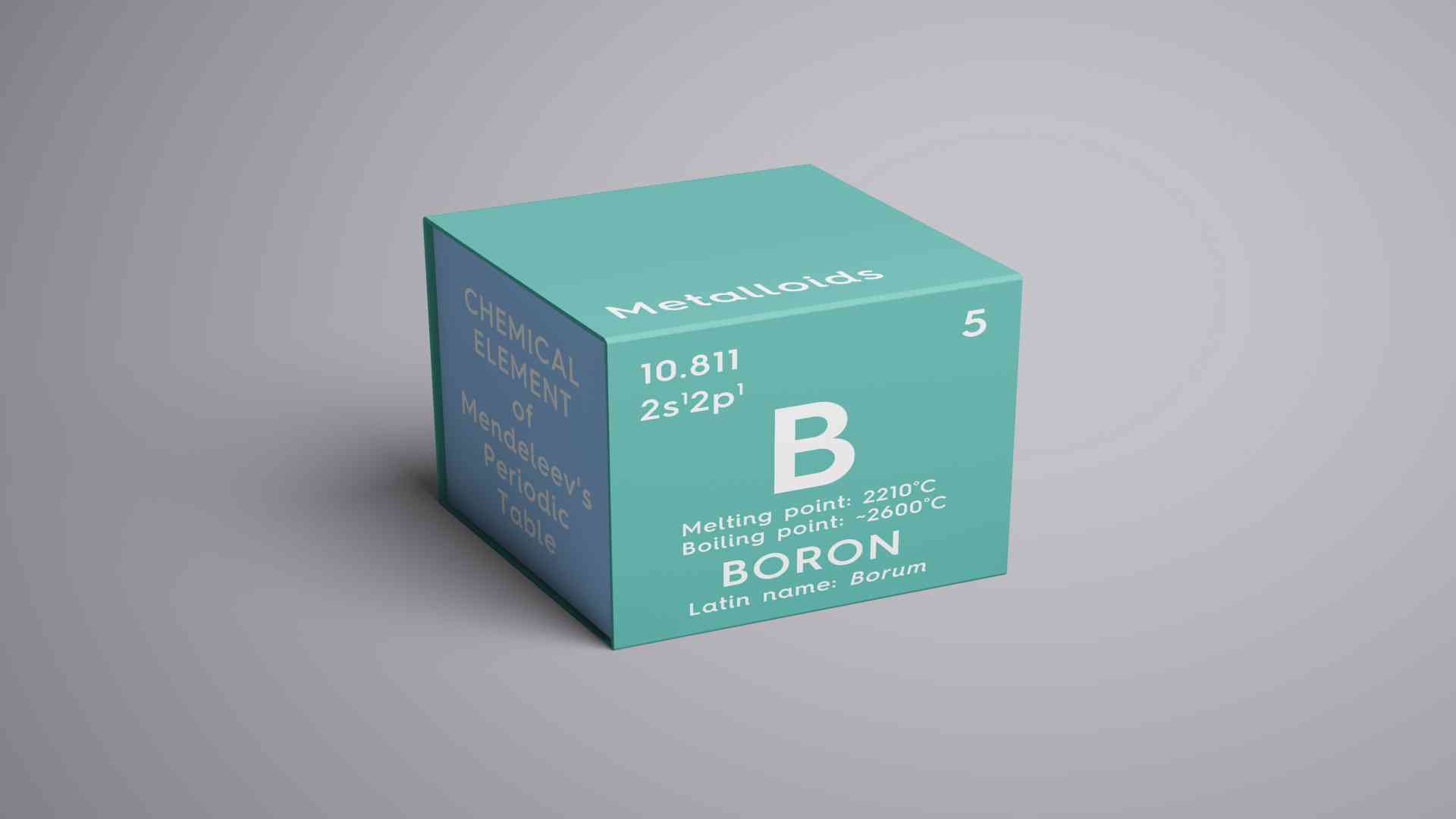Boron 101
Boron 101. Today, we’re going to talk a little bit about boron. First, we’ll talk about its chemical properties. Then we’ll look at where it’s found and the mining process to extract boron from the ground. After that, we’ll look at some applications where boron plays a significant role. And then we’ll finish up by looking at the market size and demand for boron.

Boron
Boron is a non-metal element found in nature, bound to oxygen. It’s a brittle, dark, lustrous metalloid in its crystalline form with two stable isotopes forming ionic bonds with air-stable compounds, such as boric acid and borax.
There are several forms of boron, including borates, boric acid, and boron oxide. The most common form is amorphous boron, which is a dark powder.
Boron has an atomic number of 5 with five protons and 5 electrons and its nucleus. The nucleus contains 6 neutrons. It has a melting point of 2,300 degrees centigrade or 2,573.15 Kelvins, 4,172 degrees Fahrenheit. Its boiling point is 2,550 degrees centigrade or 2,823.15 Kelvins.
Where is boron found?
Boron is primarily found in borax, kernite, and in tincalconite, which are hydrated sodium borates. And it’s mainly obtained from boron mines located in Turkey and the USA. Argentina Chile, Russia, China, and Peru. In its natural state. Boron has low solubility, meaning it forms salts relatively easily.
Boron can be mined from minerals, such as colemanite, ulexite, tincal, and kernite. The borate ore is extracted through a combination of drilling, blasting, and shoveling. The ore is then taken to crushing machines and then transported to refinery centers, where it is processed into products such as borax, borax pentahydrate, borax decahydrate, and boric acid.
A further process for extracting boron from brines of natural or industrial salt mines has been developed, including the steps of reacting borates contained in the brine with a hydrochloric acid solution.
This forms precipitates, which are separated from the brine by filtration or centrifugation. The brine is then subjected to one or more extraction stages via solvents to extract any remaining boron content.
Boron is used in various traditional applications, including fertilizers, glass production, detergents, and pharmaceuticals with exciting new uses found in decarbonization and advanced energy.
Boron is an essential micronutrient for plant growth and health, playing a role in cell walls and reproductive structures. It can be added to fertilizers either by blending with dry, granular fertilizers or mixing with liquid fertilizers but over-application of boron can lead to crop damage.
Boron is also an important component in glass production. It significantly lowers the melting temperature required for glass production. Borates are used in manufacturing to provide strength, resilience, and resistance to thermal shock, chemicals, and scratches. Boron oxide is also used in insulation and textile glass production. Borosilicate glass is a type of glass with silica and boron trioxide as the main glass-forming constituents.
Boron is used also in detergents to lower water-based solutions, and surface tension and to produce household or industrial cleaners, laundry detergents, and hand soaps. It’s also added to liquid laundry detergents up to 2% concentration to stabilize the protease and other enzymes in the formulation.
Sodium perborate requires hot water of 60 degrees centigrade to undergo hydrolysis unless an activator such as boron is present.
Boron-containing compounds are used in medicinal chemistry to improve the pharmacokinetic properties of anti-estrogens based on their glycogen-binding capability. It’s also used as a protecting group that’s released from the active drug and as the active drug component. It has been approved for human use in clinical trials such as paraboronophenylalanine for boron nutrient capture therapy.
Boron and boric acid are also found in many pharmaceutical applications including eyedrops, bone development, osteoarthritis treatment, and more.
Boron notably plays a vital role in decarbonization by reducing greenhouse gas emissions and providing multiple benefits that support carbon footprint reduction. It can also help replace more carbon-intensive materials and processes in industries, such as through the adsorption of large amounts of carbon.
Boron’s also being used in the energy transition to mitigate climate change, using renewable energy, electrical, energy efficiency, and electric mobility.
Boron is being used as an advanced energy material due to its unique properties. It’s a good conductor of electricity, extremely strong and lightweight and can provide portable energy sources serving as catalysts in chemical reactions, and potentially be used as electrode materials in lithium-ion batteries.
Boron-based furan polymers are a new class of renewable energy materials based on boron that is highly biodegradable.
Additionally, boron compounds have been studied for their potential applications in small molecule activation, hydrogen storage, and electrolytes. OLEDs and metal-ion batteries.
Boron is being further researched in a number of fuel cell ideas that use boron alloys as catalysts. Hydrogen boron fusion energy is a promising energy source for transportation and vehicles and sodium borohydride solution and potassium borohydride can be used to power small fuel cells.
Direct borohydride fuel cells (DBFCs) are a subcategory of alkaline fuel cells, which are directly fed by sodium borohydride or potassium borohydride. Boron has a very high energy density, much better than that of petroleum, which makes it an attractive alternative motor fuel.
The global boron market size was valued at $1.98 billion in 2021 and is projected to reach $2.78 billion by 2029 growing at a compound annual growth rate of 4.3% during the forecast period 2023 to 2032.
The United States holds nearly one-fifth of the world’s boron resources and is a net exporter. Major producers include Eti Maden of Turkey, Rio Tinto, Australia, US Borax, United States, Searles Valley Minerals, United States, Minera Santa Rita, Mexico. Borax Argentina, Argentina, Quiborax, Chile, and 5e Advanced Materials, formerly American Pacific Borates, which is currently the latest and only permitted source of boron in the last 20 years, based in the United States in Southern California.
And that concludes our short introduction to boron. For more information on all other aspects of boron and more depth articles and news and podcasts and videos, please go to borates.today.
Thanks for listening.





